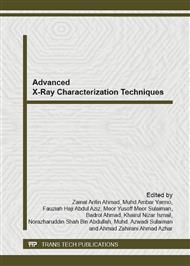[1]
Q. Like, L. Xikun, Q. Guanming, M. Weimin, S. Yanbin and Y. Huadong: Journal of Rare Earths, Vol. 25 (2007), pp.309-316.
DOI: 10.1016/s1002-0721(07)60493-1
Google Scholar
[2]
A.Z.A. Azhar, M.M. Ratnam and Z.A. Ahmad: Journal of Alloys and Compounds Vol. 478 (2009), pp.608-614.
Google Scholar
[3]
B. Smuk, M. Szutkowska and J. Walter: Journal of Materials Processing Technology Vol. 133 (2003), pp.195-198.
Google Scholar
[4]
A. Gatto: Journal of Materials Processing Technology Vol. 174 (2006), pp.67-73.
Google Scholar
[5]
A.K. Dutta, A.B. Chattopadhyaya and K.K. Ray: Wear Vol. 261 (2006), pp.885-895.
Google Scholar
[6]
B. Mondal, A.B. Chattopadhyay, A. Virkar and A. Paul: Wear Vol. 156 (1992), pp.365-383.
Google Scholar
[7]
D. Casellas, M.M. Nagl, L. Llanes and M. Anglada: Journal of Materials Processing Technology Vol. 143 (2003), pp.148-115.
Google Scholar
[8]
N.P. Bansal and S.R. Choi: National Aeronautics and Space Administration John H. Glenn Research Center, Ohio, (2003).
Google Scholar
[9]
V. Sergo, V. Lughi, G. Pezzotti, E. Lucchini, S. Meriani, N. Muraki, G. Katagiri, S. Lo Casto and T. Nishida: Wear Vol. 214 (1998), pp.264-270.
DOI: 10.1016/s0043-1648(97)00208-1
Google Scholar
[10]
G. Magnani and A. Brillante: Journal of the European Ceramic Society Vol. 25 (2005), pp.3383-3392.
Google Scholar
[11]
F. Bondioli, A.M. Ferrari, C. Leonelli, T. Manfredini, L. Linati and P. Mustarelli: Journal of the American Ceramic Society Vol. 83 (2000), p.2036-(2040).
DOI: 10.1111/j.1151-2916.2000.tb01508.x
Google Scholar
[12]
L. Zhang, M. Kuhn and U. Diebold: Surface Science Vol. 375 (1997), pp.1-12.
Google Scholar
[13]
D. -H. Riu, Y. -M. Kong and H. -E. Kim: Journal of the European Ceramic Society Vol. 20 (2000), pp.1475-1481.
Google Scholar
[14]
K. Niihara: Journal of Materials Science Letters Vol. 2 (1983), pp.221-223.
Google Scholar
[15]
M.T. Hernandez, M. González and A. De Pablos: Acta Materialia Vol. 51 (2003), pp.217-228.
Google Scholar
[16]
T. Hirata, K. Akiyama and H. Yamamoto: Journal of the European Ceramic Society Vol. 20 (2000), pp.195-199.
Google Scholar


